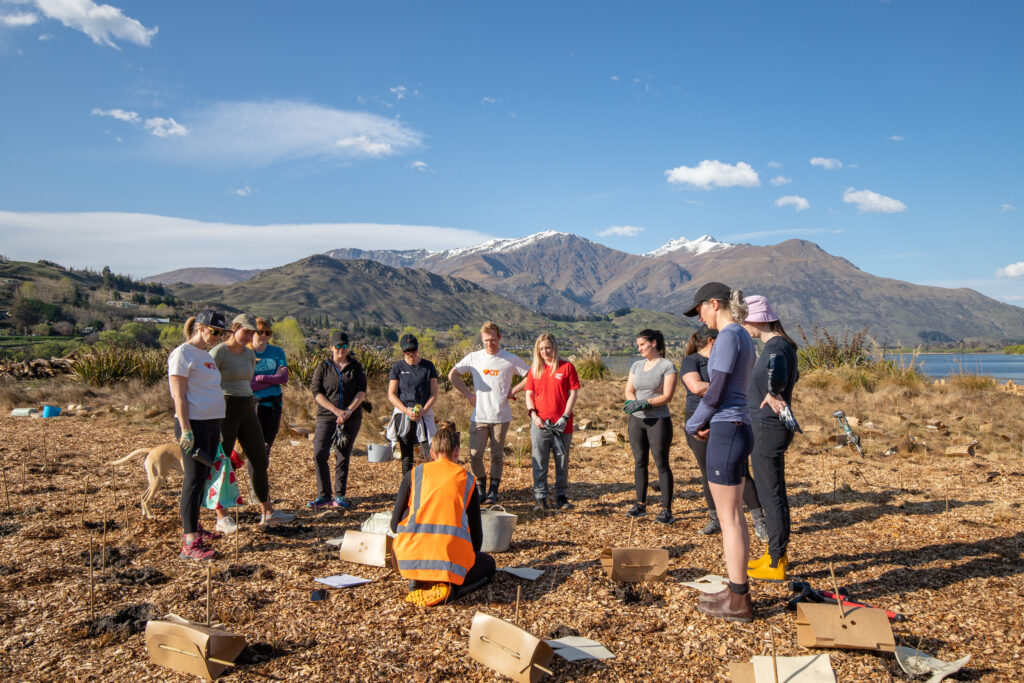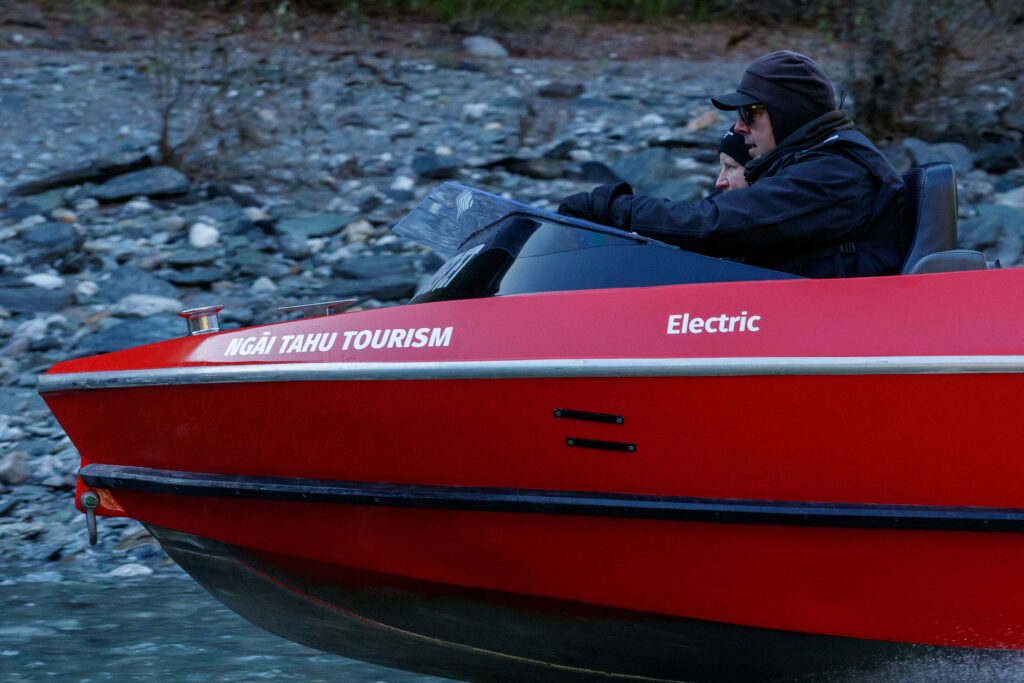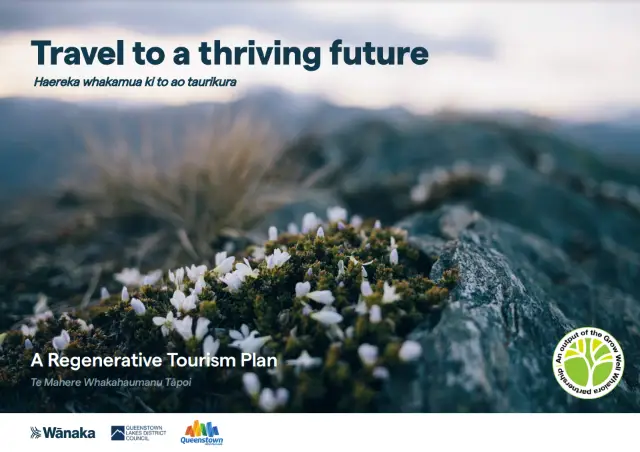THE VISION
“Travel to a Thriving Future”
Residents see tourism’s potential to ensure a thriving future for Queenstown Lakes and positively influence the world. This vision recognises that the visitor economy has an important role in achieving value economically, socially, culturally and environmentally.
Case Study Themes
Destination Management, Carbon Zero, Community, Stewardship.
Destination Website
Share
Highlights:
The Difference a Plan can make
Widespread adoption of decarbonisation initiatives by local tourism businesses.
Love Queenstown and Love Wānaka community funds established to support local climate, conservation, and biodiversity projects.
New data measurement tools being introduced to track progress.
Capability-building programme launched to support tourism operators on the journey to regenerative tourism, including reducing carbon emissions and adopting a stewardship approach in their operations.
A future-proofed tourism industry Queenstown Lakes’ can be proud of.
Destination Queenstown Case Study
A Carbon Zero Visitor Economy by 2030: The bold goal at the heart of Queenstown Lakes’ tourism future
When you’re creating a destination management plan, you’ve got to be bold, says Mat Woods, Chief Executive of Destination Queenstown.
“Our goal is a moonshot, but absolutely achievable. If you think about the Kiwi psyche – first country to give women the vote, conquered Everest, split the atom, went nuclear free in 1983 – we’re prepared to put our necks out and do something a bit brave.”
The moonshot Mat is talking about is the ‘Carbon Zero Visitor Economy 2030’ ambition Queenstown Lakes’ District has included in its Travel to a Thriving Future – Queenstown Lakes’ Regenerative Tourism Plan.
The project – which aims to ensure the region’s visitor economy achieves carbon-zero by 2030 – is one of 23 initiatives outlined in the plan, but it has been made the “keystone project” because many of the others link into it.
Mat says when the visitor economy as a whole reaches carbon zero, it will no longer be contributing to the greenhouse effect. It is not the same as carbon neutral. Reaching carbon zero by 2030 will require a relentless pursuit to cut as many carbon emissions as possible and remove the rest. He says it’s a more ambitious target than ‘carbon neutral’, which allows businesses to compensate for emissions by offsetting them through various schemes.
“We socialised the idea of doing the hardest thing possible, knowing we live in a very brave district. When we launched it at five different public events the feedback from so many people was ‘we should do that because it’s the right thing to do’.”
The region’s destination management plan is a joint effort between Destination Queenstown, Lake Wānaka Tourism and Queenstown Lakes’ District Council.
Mat and Destination Queenstown’s Marketing and Communications Director Sarah O’Donnell have been working on their region’s destination management plan since its inception and have been involved in every step of the journey, from community consultation and multiple drafts, through to its launch in 2023 and implementation.
The plan has been built into the Queenstown Lakes’ District Council’s Grow Well – Whaiora Spatial Plan – a fact Mat says gives it “real legs” by ensuring it is considered during formal council planning processes for the district’s future growth, including its transport, environmental, housing and other infrastructure needs.
A region under pressure
The need for a destination management plan was identified before 2020 – just before the global Covid-19 pandemic. It was a year Mat describes as “the peak of New Zealand tourism”, and the number of visitors travelling to Queenstown, Wānaka and some of the region’s other globally-renowned sites was reaching record levels.
Around three million visitors came to the Queenstown Lakes District in 2019 and locals were noticing traffic congestion and environmental impacts during busier months, when infrastructure such as toilets, rubbish bins and parking was under strain.
Mat says tourism’s social license to operate was being threatened and there was a need for the region’s tourism organisations to pivot from marketing and promoting Queenstown Lakes District as a destination to an approach that included stewardship and regeneration.
“We all recognised that a regenerative approach to tourism was something the region needed to embrace. Simply put, regenerative tourism gives back more than it takes, across all four wellbeing pillars, social, cultural, economic, and environmental and is the best path towards a tourism industry the Queenstown Lakes District can be proud of.”

WAO Summit 2024.
Taking community views on board
Developing a plan that ensured tourism gave more than it took and provided benefits to the wider community beyond just dollars and cents saw the parties behind the destination management plan embarking on a project to create a shared vision.
Sarah says the two regional tourism organisations and council, with support from iwi and the Department of Conservation, started by asking the basic question: “How can tourism be of service to the community to support a thriving future, rather than out to the side, with a pure economic focus?”
Answering that required extensive engagement with the community – a process carried out over 12 months with the support of a steering group, industry, community groups and other third parties.
“It wasn’t just a survey or a website, it was genuine engagement through multiple forums in locations around the district, workshops, hui with mana whenua, one on one interviews and online focus groups,” Sarah says.
“When you bring all the stakeholders together you get a really wide variety of views.”
The resulting plan covers all aspects of destination management, from enriching communities, to building economic resilience, but its keystone project of ensuring the region’s visitor economy is carbon zero by 2030 is something that sets it apart.
“The biggest piece of feedback we had was that if we were going to have a regenerative plan, we had to decarbonise,” Mat says.
“Carbon Zero 2030 is galvanising and has become our north star. Having that ambition is a rallying call.”
The decision to keep the keystone project’s timeframe short, with an end date of 2030, was intentional, Mat says.
“We thought about 2050, but so many people would just have thought – ‘that’s not on my shift’. 2040 was the same but 2030 creates real urgency,” Mat says.

Love Queenstown Tourism Industry Planting Day.
The electrifying results
Only a year after the plan’s introduction and the response from the community and region’s tourism industry has been impressive.
Ngāi Tahu Tourism – Shotover Jet has converted one of its petrol jetboats to fully-electric, some of the region’s 4WD operators are running electrically powered 4WD tours and Queenstown Airport has reduced its direct ‘scope 1’ emissions by 65% compared to 2019.
The Central Otago district is now home to the world’s first fully-electric cherry farm – The Forest Lodge Orchard in Cromwell – and regional culinary destinations Millbrook Resort and Walter Peak Station have planted on-site gardens to help supply their kitchens.
“Instead of having a six-monthly set menu, their menus are now built around what they grow and what is in season at the time,” Mat says.
Off-grid eco-lodges are popping up, proudly operating with minimal environmental footprints, and the region’s growing reputation for decarbonisation is attracting innovative Kiwi businesses, including Whoosh – a new electric overhead ride-hailing transport solution that will soon set up a pilot in Queenstown.
“They are coming to Queenstown because they see us as a shop window to the world,” he says.
There’s also the Waste to Wilderness project, run by Queenstown local Michael Sly, which collects and composts tonnes of food waste from local hotels and converts it into nutrient rich soil. The soil is then used by used by local growers for food production and groups like the Whakatipu Reforestation Trust for native tree planting projects.
“All of our operators now feed off each other’s competitiveness … there is no hardship to the visitor for taking a regenerative approach like this”.
Other early wins resulting from the destination management plan include a new capability building programme for tourism operators in the district to help them understand ways they can work towards regenerative tourism. There’s also been work done to improve the way data is captured so people can gauge progress towards the plan’s goals, and the Love Queenstown and Love Wānaka community funds have been established to support local climate, conservation, and biodiversity projects. These funds raise money through donations from the local business community and visitors for redistribution to local organisations, via contestable grants, for projects such as native revegetation, pest eradication, waterway health, and dark sky conservation.
“If you ask people to do things you need to give them the tools to do it, so these steps aim to address that issue.”

Shotover Jet Electric Jet Boat.
The keys to success
Shifting to a stewardship approach to tourism means that the benefit of any visitor needs to be assessed more holistically, rather than through a purely financial lens, Mat says.
Doing that requires a greater focus on stakeholder engagement to ensure tourism development is done in a way that complements the community’s wishes. It also requires planners to remain flexible and willing to update their approach if the community needs change.
In Queenstown Lakes’, the region’s tourism messaging has shifted to focus on ‘values-based’ marketing to showcase what locals believe in and what the region stands for. Instead of just aiming for volume of visitors, the region is now intent on attracting ‘high contributing visitors’ who explore the region more deeply, understand Queenstown and its culture, and become “temporary locals,” Mat says.
What does the future hold?
Like Mat, Sarah is hugely optimistic about the new stewardship approach and future of tourism in Queenstown Lakes.
Not only is there a growing number of conscious travellers, seeking experiences they feel good about, but adopting a regenerative approach also helps ensure tourism businesses get ahead of rules and regulations before they are introduced, she says.
“There are also cost savings, opportunities to attract investment, and staff retention and attraction benefits from taking a regenerative approach, not to mention a happier community and healthier environment.”
Ultimately, developing tourism in a way residents are proud of will result in a destination visitors will enjoy more as well, she says.
“We believe there is real competitive advantage by being carbon zero and taking a regenerative approach in our region – it really is the right thing to do.”


